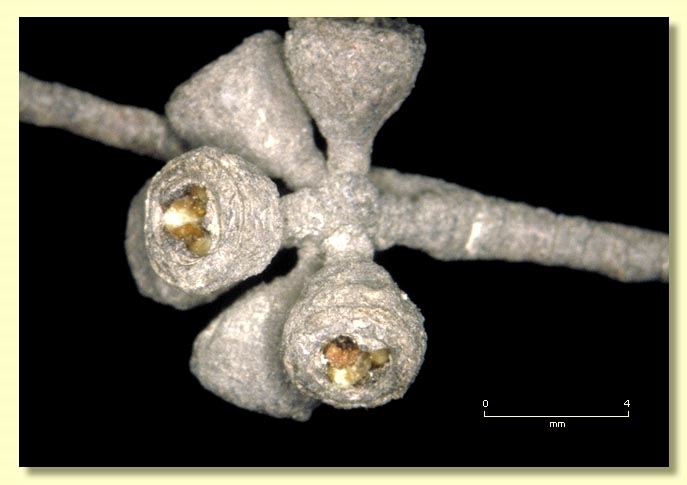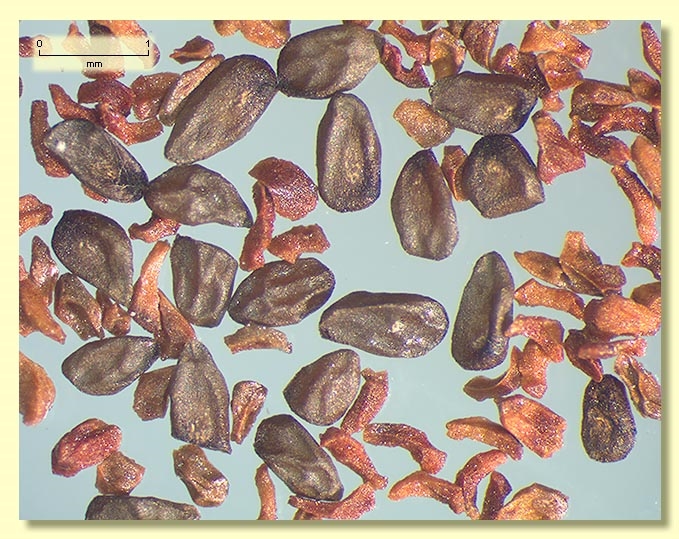Euclid - Online edition
Eucalyptus aggregata
Eucalyptus | Symphyomyrtus | Maidenaria | Triangulares | Foveolatae
Eucalyptus aggregata H.Deane & Maiden, Proc. Linn. Soc. New South Wales 24: 614 (1900).
T: New South Wales. Wallerawang, H. Deane s.n., October 1886; lectotype: NSW313030; isolectotype: NSW313029); fide Bean, A.R., Telopea 12(4): 512 (2010).
Eucalyptus rydalensis R.T.Baker & H.G.Sm., Res. Eucalypts 2nd ed., 48 (1920). T: Rydal, NSW, October 1909, ?C.Laseron s.n.; herbarium of cited specimen not known to us.
Bark rough throughout or branches <8 cm diameter smooth, rough bark flaky and fissured or fibrous, dark grey to grey-brown.
Juvenile growth (coppice or field seedlings to 50 cm): stem rounded in cross-section; juvenile leaves opposite at first but soon alternate, petiolate, ovate to elliptical or lanceolate, 4–7 cm long, 1.5–3 cm wide, margin entire or crenulate, green. Juvenile leaf shape may vary considerably in a single seedlot.
Adult leaves alternate, petioles 0.4–1.5 cm long; blade lanceolate, 5–12 cm long, 1–2.5 cm wide, slightly glossy or dull, side-veins at an acute or wider angle to midrib, moderately to densely reticulate, intramarginal vein parallel to and just within margin or well removed from it (sometimes double), oil glands mostly island.
Inflorescence axillary unbranched, peduncles 0.1–0.5 cm long, buds 7 per umbel, shortly pedicellate to rarely sessile, pedicels (0)0.1–0.2 cm long. Mature buds ovoid (0.3–0.5 cm long, 0.2–0.3 cm wide), green to yellow, scar present, operculum conical or beaked (0.15–0.3 cm long), stamens inflexed or irregularly flexed, anthers cuboid to oblong, versatile, dorsifixed, dehiscing by longitudinal slits (non-confluent), style long, locules 3 or 4, each with 4 vertical ovule rows. Flowers white or cream.
Fruit sessile to shortly pedicellate, pedicels 0–0.2 cm long, obconical, 0.2–0.5 cm long, 0.3–0.5 cm wide, disc slightly raised or level, valves 3 or 4, strongly exserted or near rim level.
Seeds brown-grey, 1.2–2 mm long, ovoid or flattened-ovoid, often pointed at one end, sometimes lacunose, dorsal surface smooth, hilum ventral.
Cultivated seedlings (measured at ca node 10): cotyledons bilobed to oblong; stems rounded in cross-section, warty or smooth; leaves sessile or shortly petiolate, opposite for 4 or 5 nodes then sub-opposite to alternate, variable in shape but usually ovate-elliptical, 3–6 cm long, 0.6–3.7 cm wide, base tapering, rounded or amplexicaul, green to grey-green.
Flowering has been recorded in January, February, April and October.
A small to medium-sized tree with extensive dark grey rough-bark, very small ovoid buds and cupular-obconical fruit. In New South Wales it occurs from Cox's River north of Lithgow to Crookwell on the Central Tablelands, to the Southern Tablelands around Nerriga, Braidwood and Jerangle, and has a small occurrence near Woodend in central Victoria. The habitat is invariably hollows and seasonally shallowly swampy ground where there may also occur the much broader-leaved swamp gum Eucalyptus ovata.
On the Southern Tablelands of New South Wales Eucalyptus macarthurii is sometimes confused with E. aggregata but the two differ in their juvenile leaves (E. macarthurii has sessile opposite broad grey-green juveniles whilst E. aggregata has green, shortly petiolate juvenile leaves that are soon alternate on the stems). In Victoria the endemic swamp gum E. yarraensis is another rough-barked species sometimes confused with E. aggregata but differs in having very glossy, undulate adult leaves and broader ovate-elliptic juvenile leaves. The Tasmanian endemic related species E. rodwayi is a taller erect tree which has conspicuous, large, glossy green, pendulous juvenile leaves but is otherwise very similar to E. aggregata .
Eucalyptus aggregata belongs in Eucalyptus subgenus Symphyomyrtus section Maidenaria because the cotyledons are bilobed, inflorescences axillary, anthers versatile and seeds flattened-ovoid. Within this large section, E. aggregata is one of ten species forming series Foveolatae further characterised by being swamp-dwellers with fruit more or less obconical.













